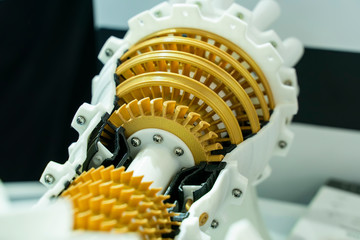With its use of liquid photopolymer droplets and UV light curing, material jetting offers high accuracy and the ability to print in full color and multiple materials. While it may not be the fastest method out there, its strength lies in producing parts with smooth surface finishes.
From prototyping to medical models, material jetting has applications across various industries. So dive in and discover all that material jetting 3D printing has to offer.
The Basics of Material Jetting 3D Printing
If you want to understand the basics of material jetting 3D printing, it uses a printhead to dispense droplets of photosensitive material that solidify under UV light, allowing for high dimensional accuracy and smooth surface finish. Material jetting is a type of additive manufacturing technology commonly used in 3D printing. It works by depositing liquid photopolymer droplets onto a build platform using either continuous or Drop-on-Demand (DOD) jetting methods. The resin used in material jetting is preheated to optimize its viscosity for precise deposition.
One advantage of material jetting is its ability to produce parts with high accuracy. With thin layer printing, it can achieve detailed and intricate designs. Additionally, material jetting allows for full-color and multi-material 3D printing, making it versatile for various applications.
However, there are some drawbacks to consider.
- Objects produced with material jetting tend to be weaker compared to other 3D printing methods.
- The printing process itself is slower, and only viscous materials can be successfully printed.
- Furthermore, the range of available materials for material jetting is limited.
Advantages and Disadvantages of Material Jetting Technology
The advantages of material jetting technology include high accuracy, full-color printing, and the ability to produce parts with smooth surface finishes. This makes it a popular choice for various applications in additive manufacturing.
Here are some key benefits of material jetting:
High Accuracy
Material jetting offers exceptional precision and dimensional accuracy, allowing for the creation of intricate designs and detailed prototypes.
Full-Color Printing
Unlike other 3D printing technologies, material jetting enables the production of parts in vibrant colors. This is particularly useful for applications where aesthetics matter, such as architectural models or artistic creations.
Smooth Surface Finishes
The ability to create parts with smooth surface finishes sets material jetting apart from other methods. This makes it suitable for applications where a high-quality appearance is desired.
Multi-Material Capability
Material jetting allows for the simultaneous printing of multiple materials or colors within a single part. This versatility opens up possibilities for creating complex designs with varying properties.
Support Removal Ease
Support structures printed during the material jetting process can be easily dissolved without leaving marks on the final part. This simplifies post-processing and reduces time and effort required for finishing.
While material jetting offers many advantages, it also has some limitations to consider. These include longer print times compared to other methods, limited range of available materials, and generally weaker objects produced. However, when used correctly in suitable applications, material jetting technology can provide excellent results in terms of accuracy and visual appeal.
Applications of Material Jetting in Various Industries
Material jetting finds applications in diverse industries, including prototyping and tooling, the medical industry for anatomical models, low-volume production of molds and casting patterns, 3D printing electronic devices, and the production of complex tooling. In the field of prototyping and tooling, material jetting offers high accuracy with thin layer printing, allowing for the creation of detailed and functional prototypes.
In the medical industry, material jetting is used to produce anatomical models that aid in surgical planning and training. It also enables low-volume production of molds and casting patterns with intricate designs. Material jetting technology can be used to 3D print electronic devices by depositing conductive materials alongside other materials to create functional circuits.
Additionally, material jetting is utilized in the production of complex tooling where precision and intricate details are required. These applications demonstrate the versatility and potential benefits of material jetting 3D printer in various industries.
Understanding the Working Principles of Material Jetting
To understand how material jetting works, imagine a printhead dispensing liquid photopolymer droplets that are cured with UV light to create each layer of the 3D printed object. Material jetting is a type of 3D printing technology that operates on the principle of depositing liquid materials and curing them layer by layer. Here’s how it works:
Liquid Resin Deposition
The process begins with the preheating of the liquid resin to optimize its viscosity for printing. The printhead then precisely deposits tiny droplets of photopolymer onto the build platform.
UV Curing
Once the droplets are in place, UV light is used to cure or solidify them, forming a solid layer. This curing process ensures that each layer adheres to the previous one and creates a strong bond.
Layer-by-Layer Building
After one layer is cured, the build platform moves downwards, allowing for the deposition and curing of subsequent layers until the complete object is formed.
Multi-Material Capability
Material jetting technology enables the printing of objects using multiple materials simultaneously. Different sections or parts can be designated for different materials or colors, providing versatility in design and functionality.
Applications
Material jetting finds applications in various industries such as prototyping, tooling manufacturing, medical modeling, and low-volume production of molds and casting patterns.
Understanding these working principles of material jetting can help you appreciate its capabilities and make informed decisions when choosing 3D printing technologies like binder jetting or metal speed binder jet for your specific needs.
Exploring the Potential of Multi-material and Full-color Printing in Material Jetting
Material jetting is a 3D printing technology that allows for accurate and fast production. With material jetting, liquid photopolymer droplets are dispensed from a printhead and cured with UV light. There are two deposit methods: continuous and Drop-on-Demand (DOD) jetting. The resin used in material jetting is preheated for better viscosity.
One of the key advantages of material jetting is its ability to enable full-color and multi-material printing. This means that different parts can be printed in different materials or colors simultaneously. Additionally, resins can be mixed to create digital materials with specific properties.
However, it’s important to note that there are some limitations with material jetting. The process tends to be slower compared to other 3D printing methods, and only viscous materials can be successfully printed. Furthermore, the range of available materials for material jetting is limited.
Despite these limitations, material jetting has found applications in various industries including prototyping, tooling, medical modeling, low-volume production of molds and casting patterns, metal binder jet, binder printer, and even 3D printing electronic devices.



